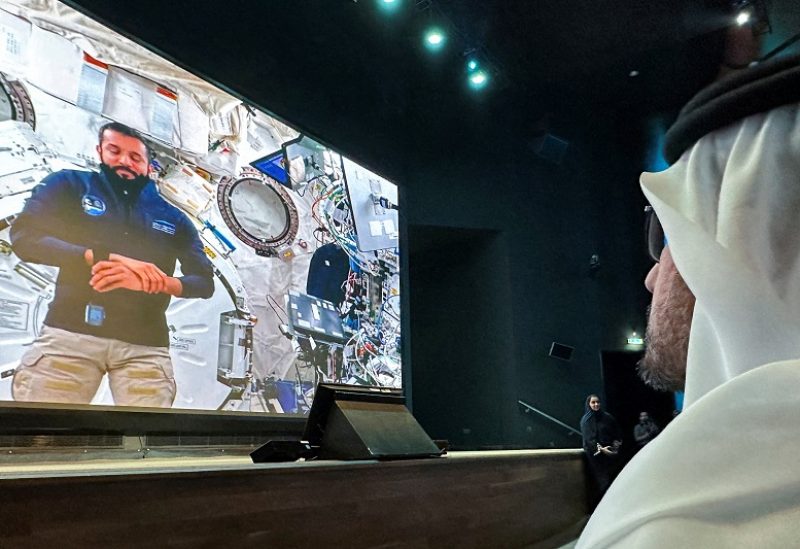
Students, scientists and physicians gather for an event at Mohamed Bin Rashid University, where they are joined via video link by Emirati astronaut Sultan Al Neyadi from space, in Dubai, United Arab Emirates June 7, 2023. REUTERS/Abdelhadi Ramahi
The upcoming visit of Japan’s Prime Minister Kishida Fumio to the UAE will emphasize the enhanced bilateral ties between the two nations, with a particular focus on collaborations in the field of space exploration.
From Mars to the moon, Japan and the UAE have worked together to explore space and conduct numerous scientific tests that will contribute to qualitative developments in the fields of science, communication technologies and robotics.
This year, Japan’s ispace Inc. worked with the Gulf country to land the UAE’s Rashid rover on the moon. Despite its failed landing, the Hakuto-R Mission 1 spacecraft, which carried the rover, managed to launch into space in December 2022.
Keeping up their strong space partnership, the UAE sent Emirati astronaut Sultan Al-Neyadi to train in Japan before his current mission.
Last year, Al-Neyadi spent a week training at Tsukuba with the Japan Aerospace Exploration Agency (JAXA) in preparation for his mission.
Al-Neyadi is a member of NASA’s SpaceX Crew-6, and embarked on a six-month mission to the International Space Station this spring.
However, the biggest space achievement of Japan and the UAE in space dates back to July 2020, when Mars Hope Probe lifted off from Tanegashima Space Center, mounted on a Mitsubishi Heavy Industries’ H-IIA launch vehicle F42.
The vehicle is Japan’s flagship launch vehicle and one of the most reliable in the world. Hope’s liftoff in July was the 45th consecutive successful H-IIA/H-IIB launch, with an accumulative success rate of 98 percent.
Preparation for the Emirates Mars Mission began six years prior to 2020, and the probe, along with the first team of Emirati engineers, spent one year in Japan to collaborate on the operation.
The collaboration between the UAE and Japan “exemplifies the distinctive strategic partnership,” according to UAE Minister of Foreign Affairs and International Cooperation Sheikh Abdullah Bin Zayed Al-Nahyan.
Japan’s former foreign minister, Toshimitsu Motegi, also praised the launch of the UAE’s Hope Probe to Mars as a “very important project” symbolizing the “strong relationship” between the two countries.
Vice President of JAXA Yasuo Ishii at the time said it was an “honor for Japan Aerospace Exploration Agency to be part of the historical launch of the Hope mission from our Tanegashima Space Centre by the H-IIA launch vehicle.”
Ishii praised the UAE’s efforts in making the first Arab mission to Mars a reality, and said he looked forward to “promoting further cooperation with the UAE in space activities.”
Japan’s former ambassador to the UAE, Akihiko Nakajima, also pointed out the “daunting task” the UAE took on but managed to complete with success.
“Integrating all the related technologies, both mature and emerging, into a single mission architecture requires excellent talents, guts and skills,” he said.
Akihiko said that the space mission yielded more opportunities for further bilateral cooperation between the UAE and Japan.
Naohiko Abe, senior vice president and head of integrated defense and space systems at MHI, said on the day of the launch: “I greatly appreciate the continuous support and cooperation of UAE’s Space Agency and MBRSC with us over the four years since MHI received the contract in March 2016.
“I sincerely hope that the successful completion of the Mars mission by the spacecraft will bring hope and delight to people all around the world in the midst of this global crisis due to COVID-19. MHI values its relationships of trust we have built over the years with the UAE government.”
In April this year, the Hope Probe released its seventh batch of data, totaling 2.1 terabytes over the course of its mission. The updates include high-cadence observations of dust movement and the first observation of stellar occultation in extreme ultraviolet wavelengths to study the Martian upper atmosphere.
The data also contained stellar occultation observations, where the instrument detects stellar light as it passes through the atmosphere of Mars, allowing for the retrieval of densities of CO2.